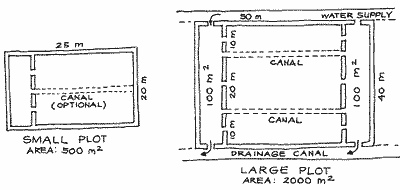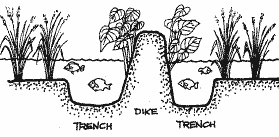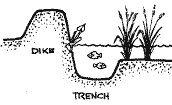


 |
Guimba, Nueva Ecija, Philippines, has rainfed and irrigated rice-based agriculture. In rainfed areas, rice is grown during the wet season and remains fallow during the rest of the year. In irrigated conditions, rice grown during the wet season is followed by another crop of rice during the dry season. Rice-fish culture is practiced by some farmers. In areas with extremely light soils, farmers plant vegetables (e.g. squash, cucumber, mungbean, stringbeans, onions, bitter gourd, etc.) and watermelon after wet season rice.
The rice-fish system practiced by farmers in Triala Village, Guimba, is concurrent rice-fish with pond refuge and is irrigation-based. This system is for growout of Nile tilapia. The operation is done as follows.
1. Site selection
2. Design and size of field
3. Fish refuge
Pond refuge, which holds more water and is less risky, is preferred over trench refuge. Refuge size is usually 10 percent of the ricefield area. Bigger refuge or a pond adjacent to the ricefield may also be connected to it through a canal.
To construct the refuge, the pond is excavated at one end, or two ends if the field is large, inside the ricefield or adjacent/alongside but connected to the field so that the fish can have access to the area planted to rice.
4. Inlet and outlet gates and screens
These are made of bamboo and other low-cost materials. Screens prevent the escape of stocked fish or entry of unwanted fish into the field.
Examples of fish refuge layout for small and large plots

1. Rice varieties - high-yielding varieties; maturity period of 120-130 days; resistant to insects and diseases.
2. Seedbed preparation and seeding rate
Size |
400-500 m2 |
Rate |
100-150 kg/ha |
Fertilization |
Broadcast urea at 25 Kg/ha 10-15 days after sowing |
3. Land preparation - After ploughing once and harrowing thrice, the field is leveled evenly so that every part of it will be uniformly irrigated.
4. Rice transplanting method
Age of seedlings : 25-30 days
Planting distance :
20-25 cm between rows
15-20 cm between hills
Straight-row planting (optional), if mechanical weeding is done.
5. Weed control - Fish stocked in ricefields control certain weeds. Weeds are also controlled through:
6. Water management - Water depth in the field when rice is newly transplanted is 3-5 cm. This is then gradually increased up to 20 cm to provide better living space for both rice and fish as they grow bigger. One week before the rice harvest, water is slowly drained so that fishes have enough time to move into the refuge.
7. Fertilizer application - The amount of fertilizer applied follows the recommended rate in the area. In Guimba, the rate applied during wet season is 200 kg/ha of ammonium phosphate and 50 kg/ha of urea for the first or basal application. The basal application is done immediately after the final leveling, which is followed by transplanting. The rate for the second application or top-dressing is 50 kg/ha. This is applied 30 days after transplanting. The amount for top-dressing may be split into two equal applications. In this case, a third application is applied 75 days after transplanting.
During dry season, the same amount for basal application is followed. For top-dressing, the rate is 100 kg/ha. As an example, the amount of fertilizer for a 400 m2 of rice-fish during wet season is 8 kg of ammonium phosphate and 2 kg of urea for basal application. For top-dressing, 2 kg of urea are needed.
8. Insect control - The use of insecticide is not recommended. Farmers, however, apply insecticides known to be less toxic to fish.
 |
 |
Colocasia sp., an aquatic plant also known as taro, is an excellent food material. It can be grown as an added commodity in a rice-fish farm. Practically, all parts of the plant can be eaten (tubers, stalks and leaves). It can also be utilized as food for fish and animals, especially pigs. The culture requirement is simple, and there are no expensive inputs.
 |
Here are steps in raising Colocasia:
1. Obtain young tubers.
2. Cut old leaves but retain the young leaves and shoot.
3. Cut the tuber into half.
4. Plant the tuber at 50-70 cm intervals along the side of the dike, about 10 cm below the water surface.
5. Start harvesting after 4-5 months.
 |
The species cultured are Nile tilapia (Oreochromis niloticus) and common carp (Cyprinus carpio). Large fingerlings, 15-25 g, are recommended as they reach harvestable size within one rice crop. If only small fingerlings (5-10 g) are available, fish culture is done in two stages:
Stage l: Raising 5-10 g fingerlings during one rice cropping (harvest size: mostly 50 g)
Stage 2: Extending fish culture period after rice harvest for up to 2 months (harvest size: 50 g)
Stocking density
Activity calendar for rice-fish culture
Code |
Day |
Activity |
a |
0 |
Prepare and fertilize seedbed. |
Supplemental feeding
Harvesting
1. Fish can contribute to increased rice yield by 10-15 percent by:
2. The increased size of dikes in the system offers opportunity to plant other crops, such as taro (Colocasia sp.), stringbeans, cowpea, wingbeans, eggplant and others.
3. The wide-scale adoption of rice-fish is still constrained by continued application of pesticide in rice-based farming. The use of pesticide is not recommended in rice-fish farming. There are ways of controlling rice pests that do not need pesticide, such as:
However, should a farmer insist on using pesticide, here are ways to apply it:
- Choose and apply pesticides that have low toxicity to fish properly.
- Minimize the amount of pesticide getting mixed with water.
- Apply at suitable time.
- Drive the fish into the refuge by draining the field before spraying. Keep the fish in the sump until toxicity in the sprayed field is gone.
- Increase water depth (+10 cm) to dilute the concentration of pesticide in the water.
- Flush water through the ricefield. Open the inlet and outlet of the field and allow irrigation water to flow freely, during spraying. Begin spraying from the outlet end of the field. When one-half of the field is already sprayed, stop for a while and allow the pesticides to flow out of the field. Then, continue spraying towards the inlet end of the field until it is finished.
To do the last two items above in applying pesticides, here are some examples: apply powder pesticides in the morning when dewdrops are still on the leaves; and apply liquid pesticides in the afternoon when leaves are dry.
There are a number of less toxic pesticides in the market Proper application of a toxic insecticide like Furadan ® or Curaterr ® can be made safe to fish if applied through soil incorporation during the final harrowing. Furadan ® is a systemic insecticide, the efficiency of which in controlling insect pests lasts about 50-55 days. Incidence of pests after this period can be controlled by spraying liquid pesticides. At this time, the rice plants have reached their full vegetative stage and the thick leaves will intercept most of the liquid sprays, thus, drastically reducing the concentration of pesticide reaching into the water.

Annual budget (in US$) for a 1 ha rice-fish farm with pond refuge
Item |
Amount |
|||
I. Returns |
Rice-fish |
Rice-fish + taro |
||
Rice (2 crops) |
1 457 |
1 457 |
||
II. Costs |
||||
Labour |
50 |
402 |
50 |
515 |
III. Net returns |
1 066 |
1 481 |
||
Partial budget (in US$) for integrating taro with rice-fish farming (1 000 m² area)

Note: Increase in net income: 31.70 - 10.95 = 20.75
Issues for further consideration Rice-fish farming was adopted by a number of farmers in the area, but not many of these have sustained their operations. The taro (i.e. Colocasia) component may be regarded as a cash or subsistence crop. Its value may vary differently by season than rice. With higher fish stocking rates as described here, supplementary feed will be necessary. Today, integrated pest management (IPM) is the declared national pest management strategy in the Philippines and many other rice-producing countries, and the International Rice Research Institute has published results that natural control of rice pests without pesticide use generally is the most profitable option for rice farmers. The concept of IPM certainly precludes the use of systemic insecticides for preventive treatment. |